Space weather forecast: Big storms ahead
The sun hurls giant plasma cannonballs at the Earth. What’s the worst that can happen?
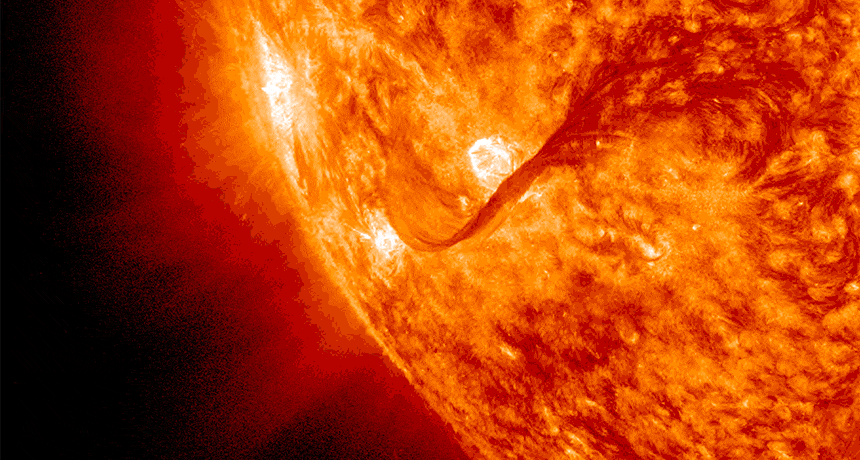
Blame it on the sun. Extreme space weather events begin when a blob of plasma erupts from the sun and streams toward Earth.
NASA/Goddard Space Flight Center
In the darkest hours of March 13, 1989, people all across North America noticed something odd overhead. They called friends and neighbors, asking the same question.
Have you seen the sky?
From New York to Florida, Cuba and Honduras, people saw the same strange thing — long streams of light. Often reported as reddish in color, these streams twisted and danced in the northern sky. Some people feared that a recently launched spacecraft had exploded. Residents of Amarillo, Texas, called the fire department. The glow looked like a distant fire, burning toward the city.
It wasn’t a fire. It was a natural phenomenon called an aurora. Auroras are common near the North and South Pole. But they rarely reach skies over southern U.S. states, such as Texas.
Something powerful — and extraterrestrial — had pushed these “northern lights” south.
In the Canadian province of Quebec, the overhead light show was just the beginning. The same event that caused the auroras also triggered a strong electric current to flow underground. That current ran into buried electrical wires. The resulting jolt overloaded the electric power grid. That’s the network of generators and wires that carry electricity.
At 2:44 a.m., lights started to go out. A minute later, the entire province of Quebec was dark. Electric-heating systems stopped working. So did elevators, even between floors. Skyscrapers in Montreal turned into looming shadows. Nine million people were powerless. That morning, the subway and airport were shut. The power company issued a statement: “All those motorists sitting at traffic lights cursing should realize that it is not [our] fault.”
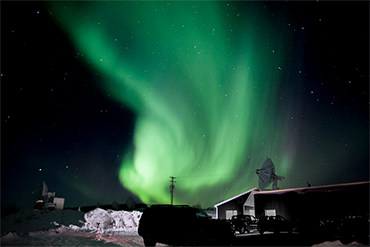
Power grids in the northern United States suffered shocks, too, but their lights didn’t go out.
The light show and blackout were caused by what scientists call a geomagnetic (JEE-oh-mag-NET-ik) storm. It occurs when an energetic stream of particles from outer space smashes into the magnetic field that surrounds and protects Earth. Geomagnetic storms are one example of space weather.
The word “weather” usually describes what happens in the lowest part of Earth’s atmosphere. Space weather describes events that happen on a much bigger scale, from the sun to the Earth.
Scientists are studying space weather to learn how to predict intense storms. As Quebec learned in 1989, those high-energy particle showers from outer space can have serious, even life-threatening consequences at Earth’s surface.
Just as with the weather on Earth, space weather is difficult to predict. But scientists already know the culprit behind every space-weather storm: our sun.
They come from outer space
Big storms like the one in 1989 begin with a belch-like expulsion of high-energy particles from the sun. This is called a coronal (Koh-ROH-nuhl) mass ejection. After a 150-million-kilometer (93-million-mile) journey, the energetic blob smashes into the Earth’s magnetic field.
“Those big blasts of material hit the Earth and cause the most severe space weather storms,” says Daniel Baker. He’s an astrophysicist at the University of Colorado Boulder. He’s been studying space weather for decades.
These storms can threaten the power grid and lead to widespread blackouts. They can damage satellites — especially ones in high orbits — or knock them out of service. Satellites enable communication and navigation around the world, so their failure would cripple many systems.
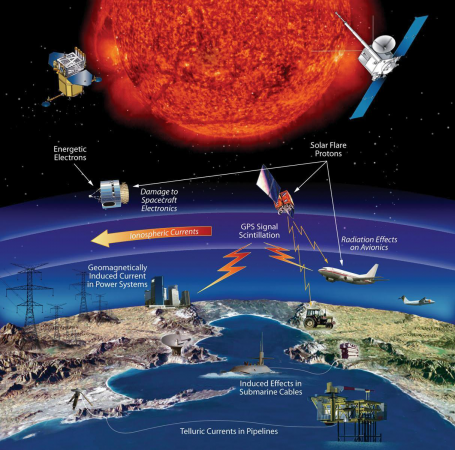
The high-energy particles also may injure astronauts or passengers on planes flying high in the sky, since spacecraft and aircraft don’t offer much protection. And some scientists predict that a strong geomagnetic storm could damage electronic devices.
Right now, researchers can’t predict such events very far in advance. They also don’t know how bad a storm may be. Part of the problem is that figuring out space weather means understanding the sun. And the sun itself is one giant, blazing, tumultuous puzzle.
Physicist Pete Riley studies how the sun’s behavior shapes space weather. He works at a company called Predictive Science in San Diego, Calif. To predict the worst-case scenario for space weather, he says, scientists have to consider two critical questions.
First, what’s the worst thing the sun can throw at us?
And second, what’s the worst damage it could do on Earth?
Telegraphs on fire
Fortunately, space storms are rare. “We’re quite well shielded most of the time by the magnetic field in the upper atmosphere,” notes Alex Hands. He’s a physicist at the University of Surrey in England. He studies space weather’s threat to satellites.
The most powerful space-weather storm known to scientists was also the first one ever observed. It occurred in 1859, the dawn of the electric age. For the first two days of September, that year, brilliant auroras lit the northern night skies. The aerial lights were so bright people could read newspapers at night, Baker says.
These were the early days of technology. Telegraphs were common, but it was 20 years before Thomas Edison would patent the first light bulb. Newspaper articles written during the space storm described telegraph machines throwing off sparks and papers near telegraph wires bursting into flame.
At the time, Richard Carrington, a British astronomer, had been studying the sun. A few days before the storm, he noticed dark splotches on the sun’s surface. We now call these sunspots, and some can be as big as Earth.
As Carrington continued to study the sun, he saw two bright flashes of light. They seemed to come from the sunspots. He suspected the sunspots and those bright flashes were connected to the curious electric storm. (Because Carrington made that connection, the 1859 storm is now known as the Carrington Event.)
Since then, scientists have confirmed Carrington’s hypotheses. Sunspots and those bright flashes, now called solar flares, are connected to space weather. In the last 160 years, scientists have figured out how to trace space-weather storms from their origins at the sun’s surface to their impacts on Earth.
The cause of these storms, explains Riley, “is all about the magnetic energy of the sun.”
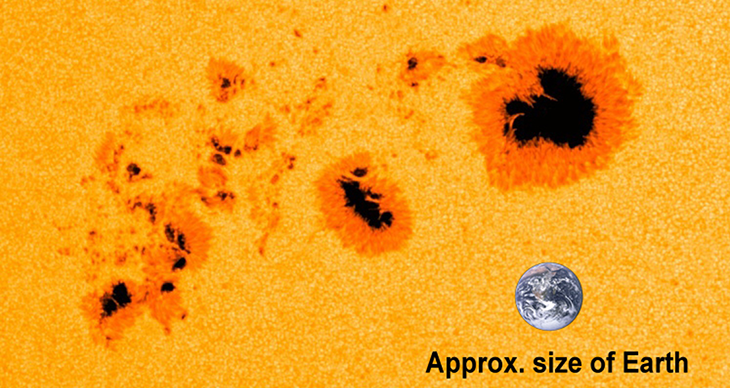
Space weather’s magnetic engine
Seen from Earth, the sun appears calm and unchanging. Up close is a different story.
The sun is a big rotating ball of churning plasma. That’s a gas made of charged particles. This makes the sun a wild place.
All that turning and churning produces magnetic fields. A magnetic field is the space around a magnet where the magnet can exert a force on other things. The Earth’s magnetic field, for example, causes a compass to point north by exerting a force on the spinning magnetic needle. (You can see the magnetic field around a bar magnet by sprinkling iron filings around it. The filings line up in parallel, curving lines that connect one end of the magnet to the other.)
The sun’s magnetic fields are more complicated. Scientists don’t know if they’re just on the surface or if they extend deep into the sun. They do know that the sun has a north pole and a south pole, just as Earth does. But unlike Earth, the sun isn’t solid. So as it rotates, those fields get twisted into spiral-like shapes. Some even stick out into space like loops.
Imagine the sun as a rotating ball of rubber bands. Each rubber band represents a magnetic field line. The middle of this ball, however, rotates at a different speed than the top and bottom. As a result, some of the rubber bands — magnetic fields — get pulled and stretched. They stretch tighter and tighter until … snap!
That snap releases energy as the field lines break and reconnect. Astronomers know that where the field lines break, the sun becomes magnetically active. These areas are more likely to have sunspots, which are signs of activity. These areas also may produce solar flares — bright flashes, as Carrington saw. A solar flare, with bright light and X-ray radiation, arrives at the Earth eight minutes after it forms.
Solar flares are often associated with coronal mass ejections, or CMEs. When the sun is active, it sun sends a few CMEs into space every day. These can be giant. Some look almost as big as the sun itself. When the sun is quieter, CMEs appear only once every few days. But don’t be fooled, says Baker. A CME from a quiet sun can still wreak havoc on Earth.
“Just because there’s a relatively low number of sunspots doesn’t mean that the sun isn’t able to produce a powerful storm that has consequences for human technology,” he says.
The magnetic activity of the sun follows a fairly regular pattern. Every 11 years, the sun’s magnetic poles switch places. Scientists call the time in between that switcheroo the solar cycle. The first few years of the cycle tend to be quiet. In the last half, the sun wakes up and things get interesting. It’s at the end of a cycle that scientists see more sunspots. That’s also when CMEs become more common.
A storm is born
The sun shoots off a CME like a giant plasma cannonball. That big blob of energy joins the solar wind, which is a steady stream of charged particles moving from the sun to the Earth. Most CMEs complete the journey in a few days. The CME that caused the Carrington Event had as much mass as a comet. It also blasted through space faster than 2,000 kilometers per second (4.5 million miles per hour). It arrived less than a day after it left the sun.
A CME is like a chunk of the sun. It even has its own magnetic field. And the direction of its field affects how much danger that CME poses to Earth. Sometimes the CME’s magnetic field lines up with Earth’s magnetic field. In such cases, magnetic north is the same in the CME as on Earth. When that happens, Earth’s field protects the planet from the extra energy.
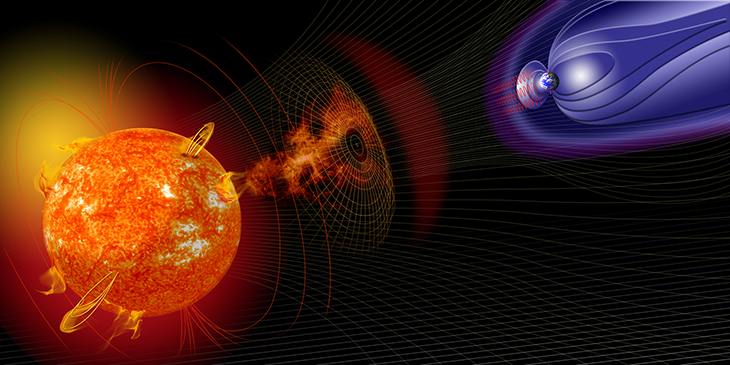
The like charges repel each other, like the north ends of two magnets will push each other away. “It’s like a glancing blow,” says Baker. The CME sort of bounces away from Earth without causing much harm.
But when the two magnetic fields are pointed in opposite ways, look out.
“It essentially opens the floodgates,” Baker says. Charged particles in the CME blow right in toward Earth. The influx of energy leads to the big geomagnetic storms that can wreak havoc.
Baker says knowing which way a CME’s field points would help scientists predict risks from an event. “It’s the most challenging thing we face in space-weather forecasting,” he says. If scientists knew how the blob lined up as it left the sun, “we’d be miles ahead in our ability to forecast.”
A near miss and the worst-case scenario
Researchers studying space weather are learning more about how energy moves through space. But they really want to know how to predict and prepare for dangerous events.
On July 23, 2012, the sun belched out a giant CME toward Earth. It missed, but not by much. If it had left the sun 10 days earlier, it would have caused problems. Baker estimates it would have triggered a geomagnetic storm even more powerful than the Carrington Event. And it would have caused much more damage. That’s because society depends far more on electronic devices now than it did 160 years ago.
“We were very fortunate,” he says. “It would have produced an extremely powerful and maybe record-breaking storm.” And we wouldn’t have been prepared. The storm would have come when the sun had been quiet for a long time. “We might have been letting our guard down a little bit.”
Predictions of worst-case scenarios suggest that a big space-weather storm now could cause damage valued at $1 trillion to $2 trillion. Some estimates suggest such a storm might also strand more than 100 million people without power — some of them for months or even years.
Hands, in England, has found that a severe space-weather storm could damage the solar panels on satellites. Afterward, they wouldn’t be able to produce enough power to work. Components onboard the satellites also would be damaged. Satellites are used for communication, navigation and defense. Given our reliance on satellites, he says, space-weather storms pose big threats.
The time to prepare is now, says Baker. Studies suggest that a storm like the Carrington Event could happen every century or so. That means we’re overdue for another big one. And because we use more and more electronic devices, we’re increasingly vulnerable, he says. “Our susceptibility to the effects of space weather increases dramatically over time.”
He says government agencies have recently begun to acknowledge that space weather is a natural hazard. The worst worst-case scenario he describes combines a powerful geomagnetic storm with a disaster like a hurricane. People could be left stranded in need of help, he says.
Indeed, he says, “It could be a very devastating thing.”







